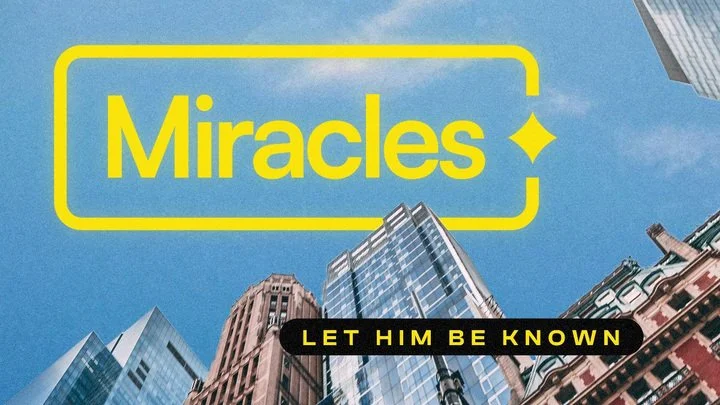Miracles: Let Him Be Known
“Healing the Paralyzed Man”
Pastor Rollan Fisher
Notes prepared by Jennifer Tower
We believe that God works miracles today by the power of the Holy Spirit to bless people and advance his kingdom. In 2023, we are believing God for miracles that will testify to his power and create new opportunities for the gospel to advance. The sermon series will focus on the 7 miracles John recounts as signs pointing people to faith in Jesus as the Son of God.
Focus: God sometimes performs miracles to deliver people from the consequences of their sins.
In essence, this is what God has done in raising Jesus from the dead.
John 5:1-15
1 After this there was a feast of the Jews, and Jesus went up to Jerusalem.
2 Now there is in Jerusalem by the Sheep Gate a pool, in Aramaic called Bethesda, which has five roofed colonnades. 3 In these lay a multitude of invalids—blind, lame, and paralyzed. 5 One man was there who had been an invalid for thirty-eight years. 6 When Jesus saw him lying there and knew that he had already been there a long time, he said to him, “Do you want to be healed?” 7 The sick man answered him, “Sir, I have no one to put me into the pool when the water is stirred up, and while I am going another steps down before me.” 8 Jesus said to him, “Get up, take up your bed, and walk.” 9 And at once the man was healed, and he took up his bed and walked.
Now that day was the Sabbath. 10 So the Jews said to the man who had been healed, “It is the Sabbath, and it is not lawful for you to take up your bed.” 11 But he answered them, “The man who healed me, that man said to me, ‘Take up your bed, and walk.’” 12 They asked him, “Who is the man who said to you, ‘Take up your bed and walk’?” 13 Now the man who had been healed did not know who it was, for Jesus had withdrawn, as there was a crowd in the place 14 Afterward Jesus found him in the temple and said to him, “See, you are well! Sin no more, that nothing worse may happen to you.” 15 The man went away and told the Jews that it was Jesus who had healed him.
“John’s gospel transcends any one historical setting. While he most likely wrote this gospel from Ephesus (the most important urban center at the time), he wrote to both Jew and Gentile. John translates Aramaic into Greek (one example of this is in this pericope) showing his awareness of non-Jewish readers.
✦ John’s gospel theme is that Jesus is the promised Messiah, the Son of God, and by believing in Jesus one can have eternal life (purpose statement found in John 20:3–31).
Surrounding Context:
✦ This encounter takes place in the first half of John’s gospel. This section is referred to as the “Book of Signs.” This, along with the other miracles recorded in this section, are recorded to show that Jesus is the Messiah.
✦ This miracle is recorded in the first half of the seven signs. These miracles in particular are to show proof of Jesus’ messianic identity.
✦ This is the first recording of Jewish opposition following the operation of the miracle, and is the first one recorded by John taking place in Jerusalem.
✦ The “festival cycle” in John’s gospel begins here and continues through chapter 10.
✦ Following this encounter (John 5:16–18) the Christological question is raised, and the Jewish contention escalates to the point of the religious leaders seeking to kill him.
Introduction—
Have you ever seen a movie where it begins with a short scene then goes back in time? As the story continues, you work your way back to that opening scene, and you see that the detail from that scene was important to you understanding the movie as it went along. As we look at today’s text, we are going to take that approach. We’re going to look at a key detail from the end of the story so that we can better understand what’s happening. In verse 14 when Jesus says “sin no more,” this lets us know that this man’s condition is a result of his sin. This encounter records what happens to the man yet also reveals us in this story. The three choices the man faces are three choices we face today.
B. Do you want to be healed? (verses 5–9)
1. The Man in the Scripture
a. It is of importance to note that even though his condition has persisted for thirty-eight years, it was not present at birth. Our “preview” from verse 14 shows us that the man’s actions precipitated his situation. As bad as his situation is, it was familiar to him. After thirty-eight years, it’s likely the only condition he remembers.
b. Jesus is fully aware of the man’s situation. He is omnipotent and yet he poses a question to the man. Does he truly want his situation to change? The man doesn’t answer yes or no. His answer reveals his helplessness (“I have no one to put me in”) and his hopelessness (“while I am going another steps down before me”).
c. Jesus responds with a three-part directive. Would he believe for the impossible, trust Jesus, and act on it?
A. Yes - he demonstrates both faith and obedience by following. His miracle was received through faith and walked out in obedience. Rising, picking up the mat, and walking would all be impossible for this man without this miracle.
B. The miracle was enacted immediately.
C. It was a gift not in any way earned by the man or caused by the pool in which the man had originally put his hope.
2. Us
a. In our context, are we aware of our condition?
Our culture has multitudes of spiritually blind, lame, and paralyzed people. It isn’t external like the multitudes of invalids by the pool, but internal infirmity is all around us. Even in the midst of it all, Jesus comes to us individually. While it is admirable that we don’t look down upon those who are “broken,” we sometimes fail to address that the situation is our own sin. We make excuses similar to the man’s, that no one will help us or that it’s someone else’s fault that we are stuck.
b. We need to truly ask ourselves if we want to be healed, and even if we do, where are we looking for it (to come from)?
Do we respond like the man and limit God’s intervention to our own understanding and knowledge? We aren’t sitting by a pool, but we may be looking for our healing to come from therapeutic means when our healing isn’t about that. It may be about acknowledging our sin and responding in obedience.
What are the pools that we are sitting by, or what places are we looking to for our healing when the One who heals is right in front of us?
C. Who is he? (verses 10-14)
1. The Man in the Scripture
a. At the time of his healing, the man is unaware of Jesus’ identity. When he first speaks to Jesus, he calls him “Sir.” When asked by the Jewish religious leaders who commanded him to get up and walk, it’s recorded that the man doesn’t know who healed him. What the man does know is that he was told, then was able, to pick up his bed and walk. He would have known his healing came from obedience to the One giving him direction and not from getting himself to the pool. Jesus comes to us even before we know it’s him.
b. The man’s revelation happens in verse 14 when they reconnect in the temple. Jesus reveals himself to the man, knowing the man’s prior sin. Jesus’ proclaims, “See, you are well! Sin no more, that nothing worse may happen to you.” Jesus is not only the man’s healer who makes him well and whole. He’s also the way to abundant life if the man would obey his commands.
2. Us
a. If you were asked, how would you answer these questions? Is Jesus “Sir” or “homeboy”? Is he man or Messiah? Is he someone you will listen to and follow his directions?
b. Is Jesus the one we turn to when we sin or when we are in need? We can’t lose the facets of our miracle-working Savior just because there are other means available to us. This should build our faith and root our perspective. It’s Jesus’ presence and his word that perform our miracles. He is not only our Savior; he must also be our Lord.
D. Who will we tell? (verse15)
1. The Man in the Scripture
a. Unlike other encounters where the receiver of a miracle goes to tell their fellow villagers, this man goes to the Jews to declare “it was Jesus who healed him.” Was this to report Jesus and absolve the man of the Jewish dissonance, or was this to enlighten them and offer the knowledge of Jesus to them? We don’t know. But we do know he had the courage and immediate response to ascribe what happened to the correct person. It may have been easier to tell his friends, but this man is even willing to proclaim Jesus to those who oppose him.
2. Us
a. Who will we tell and how will we tell our story?
E. Conclusion -
Our answer to these questions reveal the end to our story. The most important of these being, Where will our story end? Will it end with eternal life? Will it unfold with life abundant? Our answers are important. This story is good news. It’s too good not to share. We can’t help but make God known when we receive this miracle.
Second City Church - Pastor Rollan Fisher

